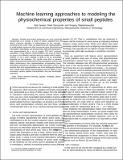| dc.contributor.author | Jensen, Kyle | |
| dc.contributor.author | Styczynski, Mark | |
| dc.contributor.author | Stephanopoulos, Gregory | |
| dc.date.accessioned | 2005-12-16T14:52:55Z | |
| dc.date.available | 2005-12-16T14:52:55Z | |
| dc.date.issued | 2006-01 | |
| dc.identifier.uri | http://hdl.handle.net/1721.1/30388 | |
| dc.description.abstract | Peptide and protein sequences are most commonly represented as a strings: a series of letters selected from the twenty character alphabet of abbreviations for the naturally occurring amino acids. Here, we experiment with representations of small peptide sequences that incorporate more physiochemical information. Specifically, we develop three different physiochemical representations for a set of roughly 700 HIV–I protease substrates. These different representations are used as input to an array of six different machine learning models which are used to predict whether or not a given peptide is likely to be an acceptable substrate for the protease. Our results show that, in general, higher–dimensional physiochemical representations tend to have better performance than representations incorporating fewer dimensions selected on the basis of high information content. We contend that such representations are more biologically relevant than simple string–based representations and are likely to more accurately capture peptide characteristics that are functionally important. | en |
| dc.description.sponsorship | Singapore-MIT Alliance (SMA) | en |
| dc.format.extent | 331891 bytes | |
| dc.format.mimetype | application/pdf | |
| dc.language.iso | en | en |
| dc.relation.ispartofseries | Molecular Engineering of Biological and Chemical Systems (MEBCS) | en |
| dc.subject | Machine learning | en |
| dc.subject | peptides | en |
| dc.subject | modeling | en |
| dc.subject | physio-chemical properties | en |
| dc.title | Machine Learning Approaches to Modeling the Physiochemical Properties of Small Peptides | en |
| dc.type | Article | en |
